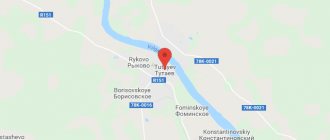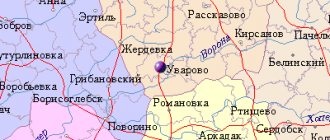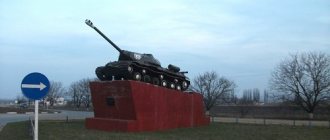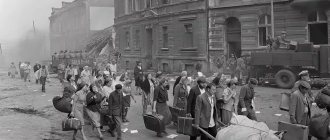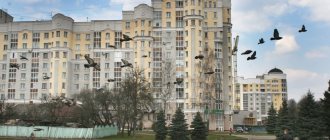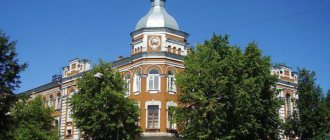| Michurinsk. In the center is the Elijah Temple |
Michurinsk
, a city in Russia, a science city, constitutes an urban district and is the administrative center of the Michurinsky district of the Tambov region, the cathedral city of the Michurin diocese. Located in the center of the European part of the country, in the western part of the Oka-Don (Tambov) plain, in the interfluve of the Volga and Don, on the right bank of the Lesnoy Voronezh River, 67 km northwest of Tambov and 69 km southeast of Lipetsk. A large junction of railway lines and roads. Population - 95.9 thousand (2015) [1].
- On the map: Yandex.Map, Google map
In 1627, Hieromonk Joseph founded a community of hermits in the nearby forests, which was renamed after the construction of the Holy Trinity Church in 1635 as the Trinity Monastery. In the autumn of the same 1635, by decree of Tsar Mikhail Feodorovich, governors Ivan Burkin and Mikhail Speshnev founded an earthen fortress to protect the southern borders of the Russian state from attacks by the Crimean Tatars and Nogais. Initially, the fortress was called the New City
, then
the New City on the Kozlov tract
, then
the New Kozlov City
, and finally simply
Kozlov
. According to one version, the name comes from the name of the Russian pioneer Semyon Kozlov, according to another - from the name of the area “Kozlovo tract”. From the middle of the 17th century it was a stronghold of defensive lines at the junction of the Belgorod and Simbirsk abatis lines.
In 1708, the city was assigned to the Azov province, in 1719 - to the Tambov province as part of the Azov (from 1725 - Voronezh) province. In the 18th century, Kozlov developed as a major trading center in an agricultural region. Since 1779 it has been a district town of the Tambov governorship, and in 1796 it was assigned to the Tambov province.
In the 19th century, trade in bread, livestock, rawhide, and cloth developed; there were handicrafts; processing of agricultural raw materials arose (mills, slaughterhouses, lard refineries, distilleries, tobacco factories, elevators); there were two iron foundries and a bell factory, and large railway workshops. In 1832, the artist A.D. Nadezhdin opened the third drawing and painting school in Russia in Kozlov. After a severe fire in 1865, the city was lined with brick houses; in the same year a railway from Moscow was built. Subsequently, the development of the railway network contributed to the growth of trade. By the end of the 19th century, the central part of the city had formed into a single historical and architectural complex.
On February 23, 1932 the city was named Michurinsk
in honor of the scientist-breeder I.V. Michurin, who lived and worked there since 1872.
In 1995, the workers' settlement of Kochetovka
. Thanks to a well-developed education system (an agricultural university, a pedagogical institute, several branches of higher educational institutions in other cities), on November 4, 2003, the city was awarded the status of a science city of the Russian Federation.
Statistics
- 1856 - 20.6 thousand people, 9 churches, 2316 houses, 348 shops
- 1897 - 40.3 thousand people
- beginning V. - 17 churches, 5 male and 2 female primary schools, 2 primary schools, a painting and drawing school, 2 shelters, 2 almshouses
- 1913 - 45.8 thousand people
- 1931 - 62.7 thousand people
- 1962 - 85 thousand people
- 1989 - 109.1 thousand people
- 2003 - 96.1 thousand people
general information
The ordinary provincial town of Michurinsk is located 73 km northwest of the regional center - Tambov. The second settlement in the region in terms of economic and cultural potential. The administrative center of the district of the same name, which it is not part of, is a city of regional subordination. In 2003, it was awarded the status of a science city of the Russian Federation. The population in 2022 was 93,330 people.
Where is Michurinsk located? In the central European part of Russia, between the Volga and Don rivers, on the right bank of the Lesnoy Voronezh river. A major transport hub in the region, through which the Caspian federal highway and the Moscow-Volgograd road pass. There are four South Eastern Railway stations in the city.
Religion
Even before the founding of the city, the Trinity Monastery for men was born here, and in 1641 the women’s Ilyinsky Monastery was built in the new fortress. Among the churches of the 18th-19th centuries, the Ilyinskaya Church (1781, presumably designed by the architect V.V. Rastrelli) and the Bogolyubsky Cathedral (1873, architect K.A. Ton, a reduced and simplified likeness of the Moscow Cathedral of Christ the Savior) stand out.
From 1869 to 1937, the Kozlov (Michurin) vicariate of the Tambov diocese operated. Since December 26, 2012, the city has become the cathedral center of the independent Michurin diocese as part of the Tambov Metropolis.
The Saints
- Sschmch. Dimitri (Dobroserdov), archbishop. Mozhaisky (+ 1937) - bishop. Kozlovsky
- Sschmch. Victor Ellansky, prot. (+ 1937) - served and served a prison sentence in the city
- Sschmch. Mikhail Bogoroditsky, prot. (+ 1937) - served in the city for more than 30 years
- Schisp. Vassian (Pyatnitsky), archbishop. b. Tambovsky (+ 1941) - bishop. Kozlovsky
- Sschmch. Matthew Kazarin, protodeacon (+ 1942) - served and served a prison term in the city
- St. Sevastian Karaganda (+ 1966) - served in the city for more than 5 years
Monasteries
- Kozlovsky (Michurinsky) Troitsky (male)
- Kozlovsky Bogolyubsky (inactive, female)
- Elias Monastery (inactive, female)
Temples
- Bogolyubskaya Icon of the Mother of God, Cathedral
- Ascension of the Lord (lost)
- Resurrection of Christ (invalid)
- Joy to all who mourn, icons of the Mother of God
- Elijah the prophet
- Michael the Archangel (lost)
- Nicholas of Myra
- Nicholas of Myra (Pushkar Church) (inactive)
- Intercession of the Blessed Virgin Mary, cathedral (lost)
- Trinity Life-Giving (Pyatnitskaya Church) (lost)
The foundation of the fort
On September 5, 1635, governors I. Birkin and M. Speshnev founded a small fortress to protect the southern borders of the Russian state from attacks by nomadic Tatars. Now the day of the city of Michurinsk is celebrated on September 22. Since the middle of the 17th century, it was a reliable stronghold on the defensive line at the junction of the Tambov and Belgorod borders, which more than once repelled attacks by nomads.
The area where Michurinsk is located has long been attractive to runaway peasants from more populated regions of the country. This is indicated, for example, by the complaint of the landowner Ivan Bobrishchev-Pushkin about the flight of serfs from his Don estate to the Kozlovsky district.
At first, the fortified point was called the “New City”, then the New City on the Kozlov Urochishche” and the “New Kozlov City”, which was gradually shortened to Kozlov. There are several generally accepted theories about the origin of the toponym. According to one of them, the city is named after the first inhabitant of the settlement, Semyon Kozlov. According to the second from the name “Kozlovo tract”. In 1932, it was renamed Michurin, in honor of the scientist-breeder I.V. Michurin, during his lifetime.
Science city Michurinsk
In the center of the European part of Russia, between the Volga and Don rivers, on the right bank of the Lesnoy Voronezh River, is the ancient Russian city of Michurinsk (until 1932 - Kozlov), with a population of 89,500 people.
Michurinsk is a city of regional subordination in the Tambov region of the Russian Federation. It is located 73 km northwest of Tambov. A large railway and highway junction. The second city in terms of economic and cultural development in the Tambov region. For success in social and economic development in 1985, he was awarded the Order of the Badge of Honor, and on November 4, 2003, by Decree of the President of the Russian Federation, he was awarded the status of a science city of the Russian Federation. Today it is the only science city in Russia that has an agricultural direction; here they are developing environmentally friendly technologies for the production, storage, processing of fruits and vegetables with therapeutic and preventive effects. The city received its name in honor of the great breeder scientist Ivan Vladimirovich Michurin, who lived and worked in the city. .Kozlov, founded in 1635 by Decree of Tsar Mikhail Romanov by governors I. Birkin and M. Speshnev, as a fortress to protect the southern borders of the Russian state from Tatar raids. Initially it was called “New City”, then “new city on Kozlovy Urochishche”, then “New Kozlovy Gorod”. There are several versions of why the city was named Kozlov. According to one of them, the name comes from the surname of the first settler Semyon Kozlov. According to another version - from the name of the area “Kozlovo tract”. From the middle of the 17th century. was a stronghold of defensive lines at the junction of the Belgorod and Tambov lines. In the 18th century, Kozlov became a major trading center. In 1708 it was assigned to the Azov province, from 1719 to the Tambov province (as part of the Azov province, from 1725 to the Voronezh province), from 1779. - a district town of the Tambov governorship, and since 1796. assigned to the Tambov province.
In the 19th century, trade in bread, livestock, rawhide, and cloth developed. There were handicrafts. In the 19th century processing of agricultural raw materials arises (mills, slaughterhouses, lard refineries, distilleries, tobacco factories, elevators). There were two iron foundries and a bell factory, and large railway workshops.
The growth of trade was facilitated by the city's location at the intersection of railways to Ryazan-Moscow, Voronezh - Rostov, Orel, Tambov - Saratov.
The spiritual and cultural life of the townspeople was also rich. At the beginning of the 20th century. in Kozlov there were branches of state banks, there were 17 churches (4 have survived), 5 men's and 2 women's primary schools, 2 primary schools, a painting and drawing school founded by A.D. Nadezhin, 2 shelters, 2 almshouses. After the fire of 1865, brick houses began to be built in Kozlov. The central part of the city is a single historical and architectural complex that developed towards the end of the 19th century.
In 1932, the city of Kozlov was renamed Michurinsk in honor of the scientist-breeder I.V. Michurin, who lived and worked in Kozlov since 1872.
Michurinsk is an all-Russian gardening center. There is the All-Russian Research Institute of Genetics and Selection of Fruit Plants named after. I.V. Michurina, VNIIS, Agrarian University. The city of Michurinsk is proud of its unique genetic collection of fruit, berry and rare plants, which was started by I.V. Michurin in 1877 Currently, the collection includes 3,000 genotypes and a hybrid fund of 120 thousand plants.
Michurinsk is rightfully considered a city of students; higher education can be obtained by studying at the Michurinsk State Agrarian University and the Michurinsk State Pedagogical Institute; in our city there are also several branches of higher educational institutions in other regions of Russia. The city has a well-developed education system. In addition, young Michurin residents have the opportunity to receive primary musical, artistic, and choreographic education in specialized schools. Graduates with specialized secondary education are trained by colleges of the food industry, agricultural, industrial and technological and medical schools.
Residents of Michurinsk are proud of their cultural traditions. One of the oldest drama theaters in the Tambov region, founded at the end of the 19th century, is actively operating here. The names of famous and recognized artists, actors, singers, writers and military leaders are associated with the city. There are 4 museums, several cinemas and cultural centers operating successfully in Michurinsk.
Michurinsk is a hospitable city in the very center of Russia, where kind, hardworking and talented people live.
On November 4, 2003, the President of the Russian Federation V. Putin signed Decree No. 1306 on assigning the status of a science city of the Russian Federation to the city of Michurinsk, Tambov Region.
Development of the region
Around the beginning of the 18th century, Kozlov began to develop as a regional center, which concentrated trade in the region's agricultural products. Trade in wheat, cattle, salt, rawhide, cloth and silk flourished in the small town. The first handicrafts also appeared, which later grew into full-fledged production. In the 19th century, many enterprises related to the processing of agricultural raw materials began operating: elevators, slaughterhouses, mills, tobacco factories, lard refineries and distilleries.
In the twentieth century, several small metallurgical plants operated in Kozlov (Tambov region). A significant contribution to the development of the city was made by the construction of the railway, which operated large railway workshops (now a locomotive repair plant). Around the same time, the architectural appearance of the historical part of the city took shape, which has been preserved to this day.
Plant Breeding Center
The city of Kozlov became widely known already in Soviet times thanks to the active propaganda of the activities of Ivan Vladimirovich Michurin. Who moved here in 1872 and never left. Using his own funds, he began to develop new varieties of garden crops. By 1917, his nursery grew more than 900 species of plants from around the world.
The scientist himself expressed a desire to work for the new government. In 1918, his nursery was nationalized, Michurin himself became the manager and received funding to continue the work. In 1934, a genetic laboratory was organized, which later grew into the Institute of Genetics and Selection of Fruit Plants, named after him.
Science City
The region where Michurinsk is located has been a recognized center of Russian gardening since pre-revolutionary times. The city is home to several scientific and educational institutions dealing with breeding, genetics and horticulture. In 2003, it was awarded the status of a science city with specialization in scientific and innovative activities in the agricultural sector. Institutes and high-tech enterprises were supposed to engage in fundamental research in the field of genetics, breeding, and biotechnology of berry, fruit and vegetable crops; development of experimental technologies for the production of fruits and vegetables; development of various types of plant food products, including special and health products.
In 2010, by decree, the government decided to create the Green Valley agro-industrial technology park in Michurinsk, which specializes in the cultivation and processing of agricultural raw materials. In addition, it is intended to produce plant-based foods for a healthy diet with genetically specified properties.
Michurinsk
(Tambov Region)
OKATO code:
68415
Founded:
1635
City since:
1779 City of regional subordination
Center:
Michurinsky district
The city was formerly called:
| Kozlov | 1635 | 1932 |
| Telephone code (reference phone) | |
| 47545***** | 50-00-7 |
Deviation from Moscow time, hours:
0
Geographic latitude:
52°54′
Geographic longitude:
40°29′
Altitude above sea level, meters:
150 Sunrise and sunset times of the Sun and Moon in the city of Michurinsk
